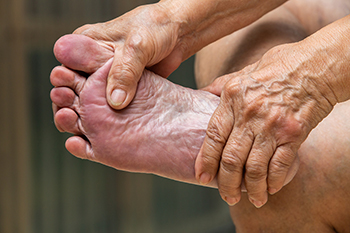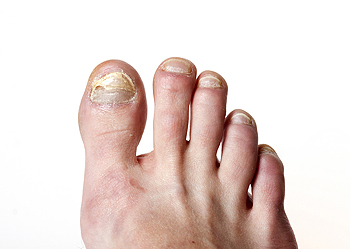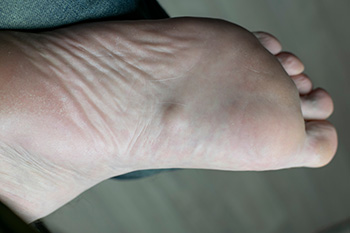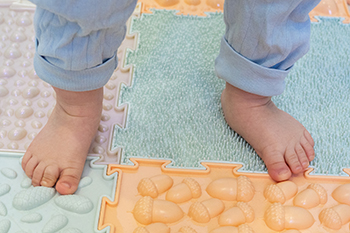Connect With Us
Blog
Items filtered by date: August 2024
Let the Expert Treat Your Ingrown Toenails
How Aging Impacts Foot Health

As people age, their feet often experience significant changes that can lead to various issues. Dry skin is a common problem, as decreased moisture and thinner skin can lead to cracking and discomfort. Flat feet may develop or worsen, as the arch tends to flatten over time due to weakened ligaments and tendons. Hammertoe is another prevalent condition where the toes become bent and rigid, causing pain and difficulty in walking. Additionally, the Achilles tendon can shorten and become less flexible with age, leading to heel pain and limited mobility. To manage these issues, it is important to keep feet moisturized, choose supportive footwear, and perform stretching exercises to maintain flexibility. If you are elderly or are caring for a senior citizen, it is suggested that you schedule regular appointments with a podiatrist who can treat any foot condition, and monitor foot health.
Proper foot care is something many older adults forget to consider. If you have any concerns about your feet and ankles, contact Janale Beckford, DPM from Tampa Podiatrists . Our doctor can provide the care you need to keep you pain-free and on your feet.
The Elderly and Their Feet
As we age we start to notice many changes in our body, but the elder population may not notice them right away. Medical conditions may prevent the elderly to take notice of their foot health right away. Poor vision is a lead contributor to not taking action for the elderly.
Common Conditions
- Neuropathy – can reduce feeling in the feet and can hide many life-threatening medical conditions.
- Reduced flexibility – prevents the ability of proper toenail trimming, and foot cleaning. If left untreated, it may lead to further medical issues.
- Foot sores – amongst the older population can be serious before they are discovered. Some of the problematic conditions they may face are:
- Gouging toenails affecting nearby toe
- Shoes that don’t fit properly
- Pressure sores
- Loss of circulation in legs & feet
- Edema & swelling of feet and ankles
Susceptible Infections
Diabetes and poor circulation can cause general loss of sensitivity over the years, turning a simple cut into a serious issue.
If you have any questions please feel free to contact our office located in Tampa, FL . We offer the newest diagnostic and treatment technologies for all your foot and ankle needs.
Facts About Fungal Toenails

Fungi, which reside on the body, can thrive over time in or on the toenail. This can result in an infection known as onychomycosis, or fungal toenail. You can also pick up onychomycosis through contact with someone who has it. Additionally, this fungal infection can be transmitted through contact with toenail clippers, nail files, or pedicure instruments at a salon where fungi are present. Older adults whose drier nails make it easier for fungi to enter the nail are more prone to developing fungal toenail infections. Additionally, people who wear fake nails, use public swimming pools, or have diabetes or a weakened immune system may be successiptble to developing toenail fungus. People whose feet are confined to warm, moist environments where fungi thrive are also more at risk of developing fungal nails. Fungal nail symptoms include brittle, thickened, discolored or distorted nails, which can sometimes be accompanied by odor or pain. While some people try to treat fungal toenail infections at home, the fungi can be very stubborn and resilient. If you have toenail fungus, It is suggested that you schedule an appointment with a podiatrist to address the issue and prevent it from recurring.
For more information about treatment, contact Janale Beckford, DPM of Tampa Podiatrists . Our doctor can provide the care you need to keep you pain-free and on your feet.
Toenail Fungus Treatment
Toenail fungus is a condition that affects many people and can be especially hard to get rid of. Fortunately, there are several methods to go about treating and avoiding it.
Antifungals & Deterrence
Oral antifungal medicine has been shown to be effective in many cases. It is important to consult with a podiatrist to determine the proper regiment for you, or potentially explore other options.
Applying foot powder on the feet and shoes helps keep the feet free of moisture and sweat.
Sandals or open toed shoes – Wearing these will allow air movement and help keep feet dry. They also expose your feet to light, which fungus cannot tolerate. Socks with moisture wicking material also help as well.
If you have any questions please feel free to contact our office located in Tampa, FL . We offer the newest diagnostic tools and technology to treat your foot and ankle needs.
Facts About Plantar Fibroma

Plantar fibromatosis, also known as Ledderhose disease, is a condition characterized by the formation of non-cancerous nodules in the plantar fascia, the connective tissue along the bottom of the foot. These nodules are typically firm, painless lumps but can cause discomfort and affect foot function as they grow. Common signs include a noticeable bump on the foot's arch and possible pain or pressure when walking. Diagnosing plantar fibroma involves a physical examination by a podiatrist, who will assess the size and location of the nodules. Imaging tests, such as ultrasounds or MRI scans, may be used to confirm the diagnosis and evaluate the extent of the fibromas. If you have a nodule on your foot, it is suggested that you schedule an appointment with a podiatrist who can accurately diagnose and treat plantar fibromas.
A plantar fibroma may disrupt your daily activities. If you have any concerns, contact Janale Beckford, DPM of Tampa Podiatrists . Our doctor can provide the care you need to keep you pain-free and on your feet.
Plantar Fibroma
A plantar fibroma is a fibrous knot in the arch of the foot. It is embedded in the plantar fascia which is a band of tissue that extends from the heel to the toes along the bottom of the foot. There can be multiple plantar fibromas in the feet at the same time. There are no known causes for this condition. If you have a plantar fibroma, there will be a bump in the arch of your foot that cannot be missed. Any associated pain is most often due to a shoe rubbing against the nodule. Non-surgical options, such as steroid injections, physical therapy, and orthotics should be tried first. Surgery is a last resort and is the only thing that will remove a plantar fibroma entirely. Consult with a podiatrist for a proper diagnosis and to determine the treatment regimen that is right for you.
What Causes a Plantar Fibroma?
While there are no specific causes identified, a plantar fibroma can possibly come from genetic predisposition or the formation of scar tissue that forms from healing the tears in the plantar fascia.
What Are the Symptoms of a Plantar Fibroma?
There will be a noticeable lump in the arch of the foot that may or may not cause pain. If pain is felt, it is typically because a shoe is rubbing up against the lump or when walking or standing barefoot.
Treatment and Prevention
A plantar fibroma will not disappear without treatment, but it can get smaller and be a non-issue. If pain persists, a podiatrist examines the foot and when the arch of the foot is pressed, pain can be felt down to the toes. An MRI or biopsy might be performed to help diagnose or evaluate the plantar fibroma. The following non-surgical options are generally enough to reduce the size and pain of these nodules:
- Steroid injections
- Orthotics
- Physical therapy to help apply anti-inflammatory creams on the bump
Surgery is considered if the mass increases in size and the patient continues to feel pain after non-surgical methods are tried.
If you have any questions please feel free to contact our office located in Tampa, FL . We offer the newest diagnostic tools and technology to treat your foot and ankle needs.
Managing Children’s Flat Feet
 Flat feet, or pes planus, in children, is a condition where the arches of the feet do not develop properly, resulting in the entire sole touching the ground. Often, this condition is flexible, with the arch appearing while sitting or standing on tiptoe, but disappearing when standing flat. Causes include genetics, ligament laxity, or underlying conditions like cerebral palsy. Children with flat feet often experience overpronation, where the ankles roll inward excessively. Overpronation can be mild, moderate, or severe, based on the degree of inward roll. Many children experience no symptoms and often outgrow flat feet as their arches develop naturally, usually by age six. However, some may experience pain, fatigue, or difficulty with physical activities requiring intervention. Rarely, severe cases may require surgical treatment. If your child is experiencing discomfort from flat feet, it is suggested that you schedule an appointment with a podiatrist who can provide recommendations which may include wearing supportive footwear, orthotic inserts, or stretching exercises to strengthen foot muscles and improve posture.
Flat feet, or pes planus, in children, is a condition where the arches of the feet do not develop properly, resulting in the entire sole touching the ground. Often, this condition is flexible, with the arch appearing while sitting or standing on tiptoe, but disappearing when standing flat. Causes include genetics, ligament laxity, or underlying conditions like cerebral palsy. Children with flat feet often experience overpronation, where the ankles roll inward excessively. Overpronation can be mild, moderate, or severe, based on the degree of inward roll. Many children experience no symptoms and often outgrow flat feet as their arches develop naturally, usually by age six. However, some may experience pain, fatigue, or difficulty with physical activities requiring intervention. Rarely, severe cases may require surgical treatment. If your child is experiencing discomfort from flat feet, it is suggested that you schedule an appointment with a podiatrist who can provide recommendations which may include wearing supportive footwear, orthotic inserts, or stretching exercises to strengthen foot muscles and improve posture.
Making sure that your children maintain good foot health is very important as they grow. If you have any questions, contact Janale Beckford, DPM of Tampa Podiatrists . Our doctor can provide the care you need to keep you pain-free and on your feet.
Keeping Children's Feet Healthy
Having healthy feet during childhood can help prevent medical problems later in life, namely in the back and legs. As children grow, their feet require different types of care. Here are some things to consider...
Although babies do not walk yet, it is still very important to take care of their feet.
Avoid putting tight shoes or socks on his or her feet.
Allow the baby to stretch and kick his or her feet to feel comfortable.
As a toddler, kids are now on the move and begin to develop differently. At this age, toddlers are getting a feel for walking, so don’t be alarmed if your toddler is unsteady or ‘walks funny’.
As your child gets older, it is important to teach them how to take care of their feet.
Show them proper hygiene to prevent infections such as fungus.
Be watchful for any pain or injury.
Have all injuries checked by a doctor as soon as possible.
Comfortable, protective shoes should always be worn, especially at play.
If you have any questions please feel free to contact our office located in Tampa, FL . We offer the newest diagnostic and treatment technologies for all your foot and ankle needs.

